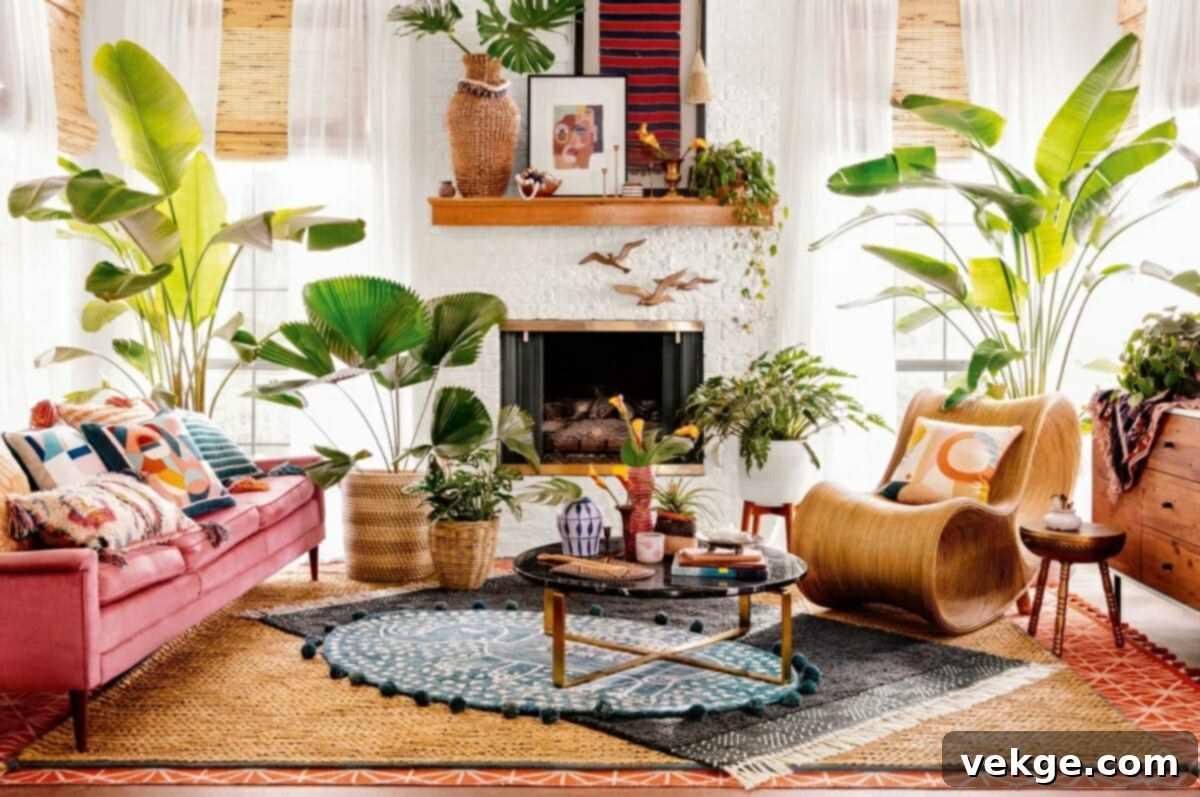Embrace the Free Spirit: A Comprehensive Guide to Bohemian Furniture & Decor
Have you ever stepped into a home adorned with a captivating blend of earthy tones, vibrant greens and blues, and an abundance of lush plants gracefully hanging or nestled in corners? Chances are, you’ve experienced the enchanting allure of a bohemian-inspired interior. Over the past few years, boho-styled spaces have captured the hearts of countless individuals. This enduring popularity stems from its inherent freedom, allowing people to express their unique personalities and experiment with design in a truly personal way. At its core, the bohemian aesthetic is synonymous with a free-spirited approach to living and decorating.
What truly makes boho interiors so distinct and inviting? The answer lies significantly in its furniture. Boho furniture is far from conventional; it boasts an array of distinctive patterns, rich textures, and a spectrum of colors that tell a story. It’s incredibly diverse, often reflecting a beautiful amalgamation of different global cultures. Above all else, bohemian furniture champions originality, creativity, and unparalleled comfort, transforming any living space into a personal sanctuary.
But where did this fascinating boho furniture concept originate? What are the defining characteristics that set it apart? Let’s delve deep into the world of bohemian furniture and uncover its captivating history and features.
The History of Boho Furniture
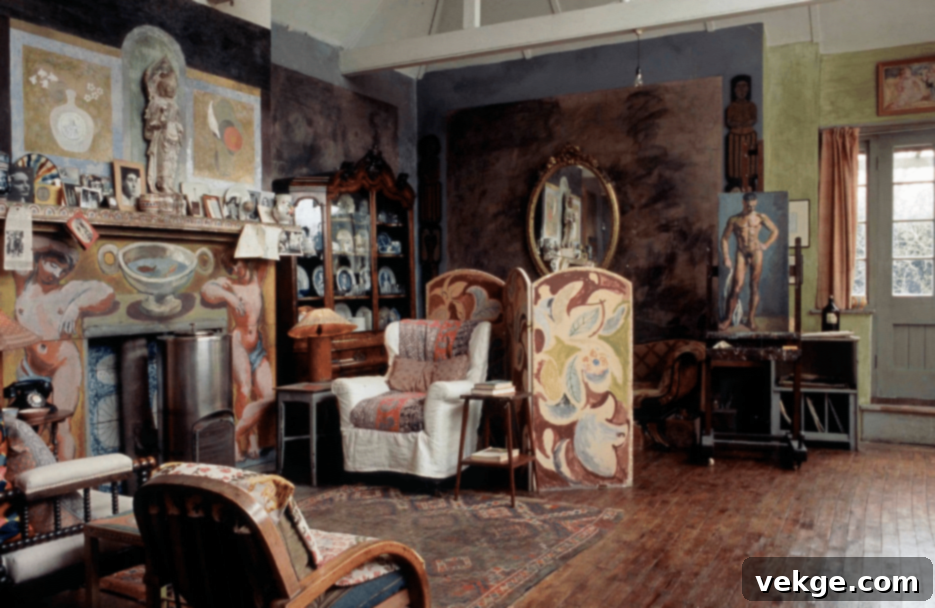
The term ‘bohemian’ first emerged in France during the 19th century. Initially, it was used to describe a specific group of individuals: authors, artists, musicians, and other intellectuals who often led an unconventional, nomadic, and typically impoverished lifestyle, much like the Romani people (who were mistakenly believed to originate from Bohemia, a region in the Czech Republic). These individuals were characterized by their non-conformist worldview, a rejection of societal norms, and a strong sense of individuality and uniqueness. The distinctive style they embraced—whether in their clothing, art, or the goods they created and sold—became known as the “boho look.” This initial association with artistic freedom and a wanderlust spirit laid the foundation for the bohemian aesthetic we recognize today.
Over time, the boho style evolved significantly, moving beyond just a lifestyle to a recognized interior design movement. Its transformation in recent years has involved a rich fusion of cultural influences, drawing inspiration from the intricate patterns of Morocco, the vibrant textiles and craftsmanship of India, and the earthy, spiritual motifs of Native American art. This blend of global aesthetics creates a layered, well-traveled, and deeply personal style that continues to resonate with contemporary design enthusiasts.
Features of Boho Furniture
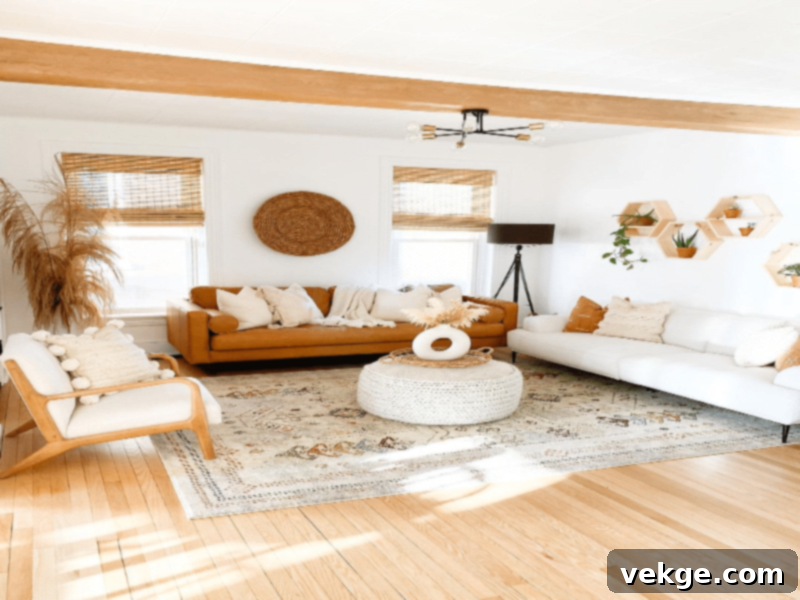
As previously mentioned, boho furniture is celebrated for its dynamic combination of various hues, intricate motifs, and diverse textures. This deliberate mix works in harmony to cultivate a genuinely warm, inviting, and utterly comfortable environment. The strategic placement of unique and varied items in every corner enhances the overall aesthetic appeal, creating a space that feels curated and lived-in. Beyond its visual charm, bohemian furniture possesses several other salient features that collectively define its distinctive and much-loved style, making it a truly unique choice for any home.
1. Eclectic Mix
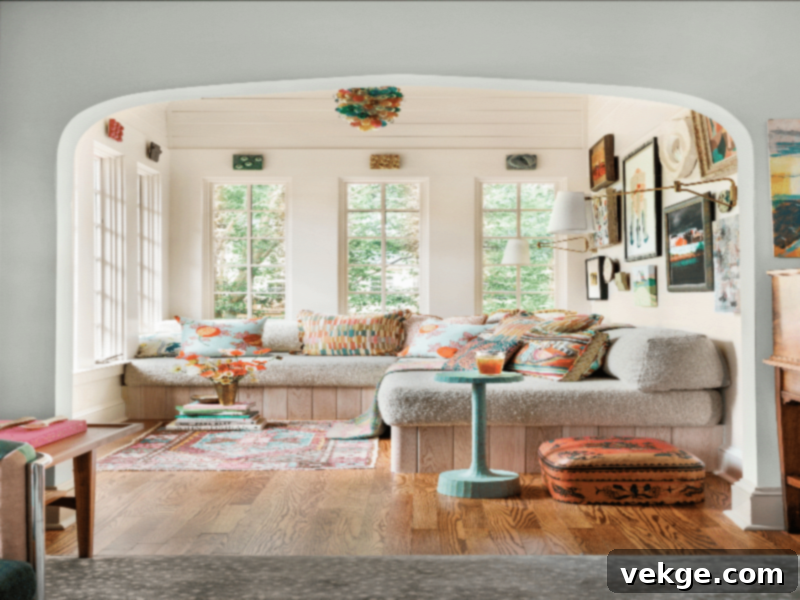
The eclectic style stands as one of the most defining and beloved characteristics of boho furniture. In the context of bohemian design, “eclectic” signifies a harmonious blend of items from different eras, styles, and origins—often mixing modern pieces with antique treasures. This is precisely what boho furniture is renowned for. Imagine a single room adorned with a boho theme where a sleek, contemporary sofa might sit beside a beautifully aged, hand-carved wooden side table, or a plush velvet armchair complements a vintage rattan room divider. This fusion of traditional and contemporary elements is how bohemian decor imbues a space with profound personality, rich history, and captivating depth. It’s about creating a narrative with your furniture, where each piece tells a part of your story and travels.
2. Bright Colors

Boho furniture enthusiastically embraces a rich and wonderfully varied color scheme, making it a hallmark of the style. However, the selection of colors is approached with deliberate care, ensuring that while vibrant, they contribute to a cohesive and inviting atmosphere. The palette typically spans from grounding earthy tones like olive green, rustic rust, and warm terracotta, to bold, saturated hues such as deep blues, energetic bright oranges, and luxurious rich purples. These lively colors are often balanced by more neutral backdrops, allowing them to pop without overwhelming the senses. This characteristic combination of muted and intense colors creates a dynamic yet cozy and friendly ambiance, reflecting the free-spirited and joyful nature of bohemian design.
3. Natural Materials
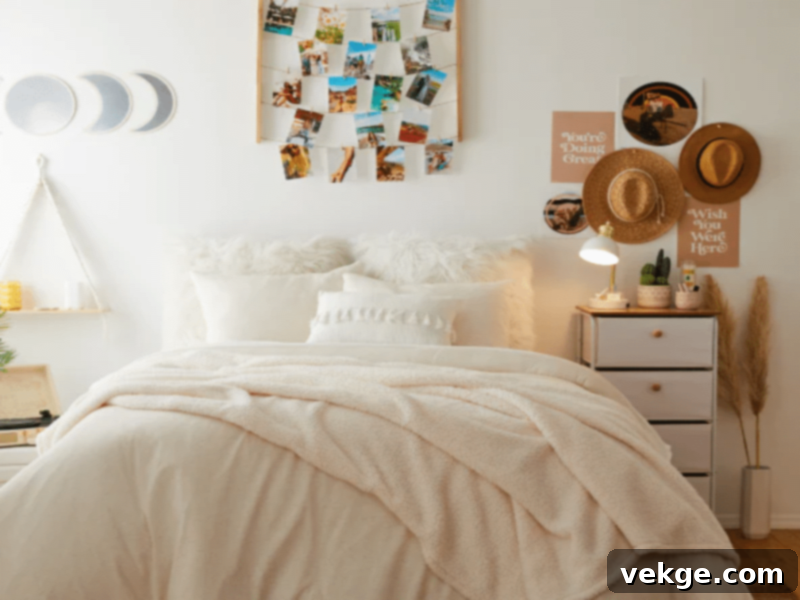
Another incredibly appealing and significant feature of boho furniture is its deep connection to nature and its eco-friendly essence. This style heavily prioritizes furniture crafted from natural, organic materials. You’ll frequently find materials like robust wood, intricately woven rattan, lightweight bamboo, and durable jute playing prominent roles in creating authentic bohemian interior designs. The philosophy behind using these organic materials is multifaceted: they inherently exude a fresh, earthy vibe, contribute to a sense of serenity and well-being, and make guests feel incredibly comfortable and connected to the natural world. Moreover, these materials elevate the aesthetic, adding texture, warmth, and a timeless quality that manufactured materials simply cannot replicate. Think carved wooden tables, bamboo chairs, and jute rugs that infuse the space with an undeniable sense of calm and organic beauty.
4. Layered Textures
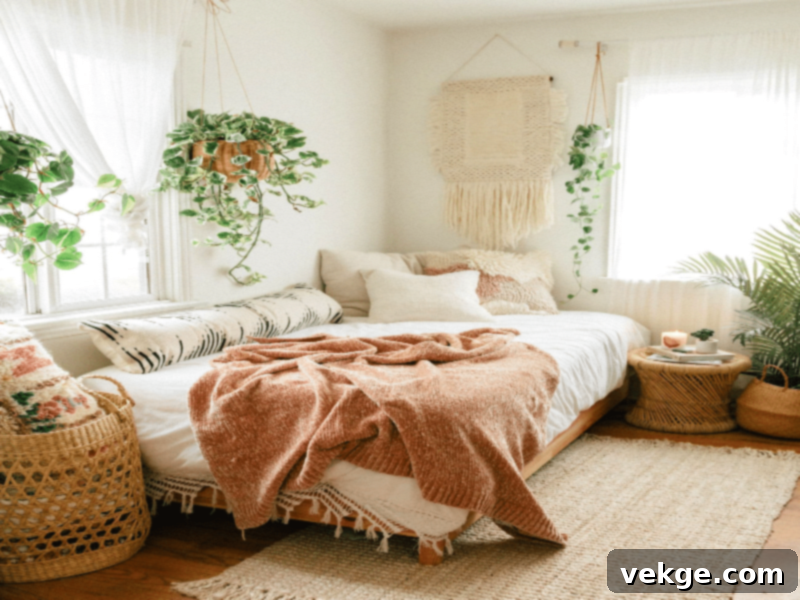
Achieving the quintessential bohemian style is heavily reliant on the artful layering of various textures. This technique adds depth, comfort, and visual interest to a space, making it feel rich and inviting. For instance, soft and luxurious elements like velvet couches, chunky knit throws, or plush, comfortable carpets can be used to introduce a sumptuous, soft texture. On the other hand, more complex and rustic textures, such as woven jute rugs, macrame wall hangings, or rough-hewn wooden furniture, can be incorporated to create a beautiful balance. The interplay between these diverse textures not only makes the area incredibly cozier and more tactile but also renders it aesthetically captivating, inviting both the eye and the hand to explore its rich surfaces. This sensory experience is a cornerstone of bohemian comfort and style.
5. Diverse Culture
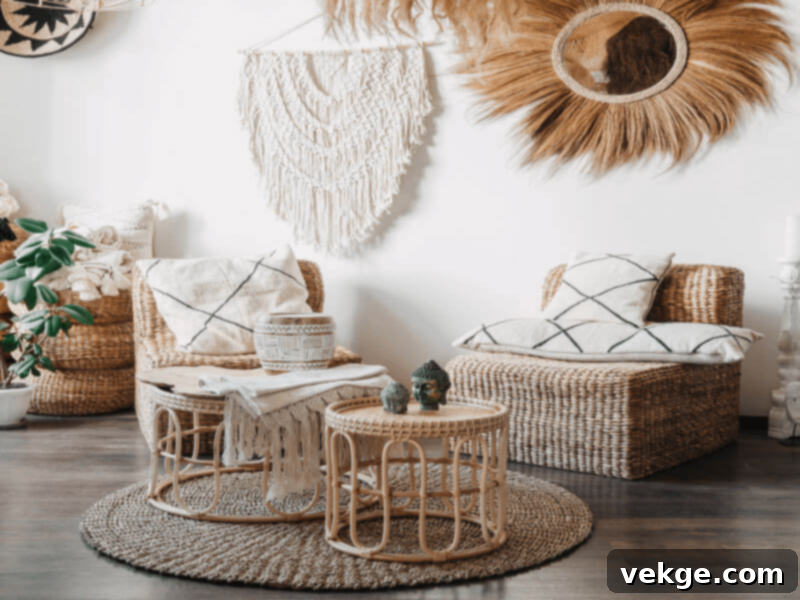
Boho furniture and decor are profoundly influenced by a multitude of global cultures, embodying a spirit of wanderlust and appreciation for diverse artistic traditions. A truly well-traveled and culturally rich interior boho theme is essentially a vibrant tapestry woven from different influences found all over the world. This extensive range can manifest in many forms: from the intricate metalwork of Moroccan lamps casting atmospheric shadows, to the vibrant, hand-knotted patterns of Indian carpets grounding a room, and the striking geometric designs of African wall displays. These elements are not just decorative; they tell stories of distant lands, ancient crafts, and diverse philosophies, contributing to an interior that feels lived-in, thoughtful, and deeply connected to global heritage.
6. Artistic Flair
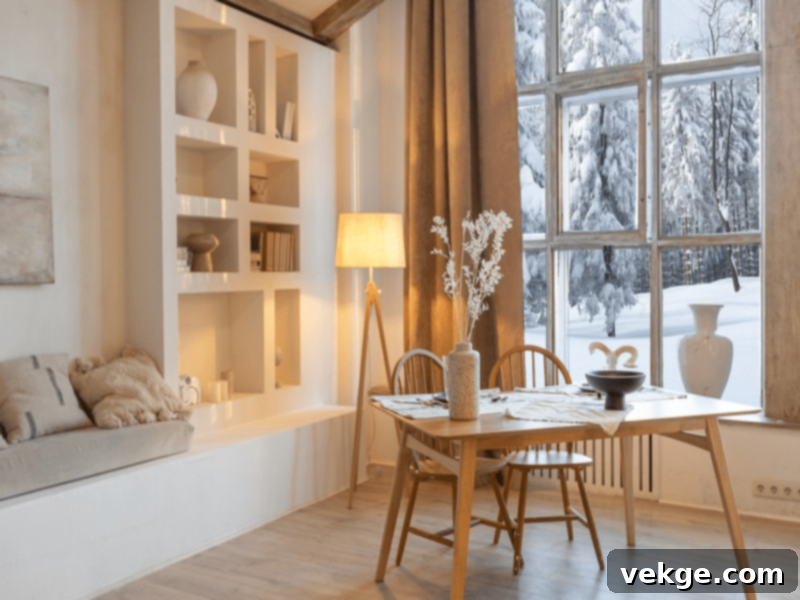
Art is undeniably central and eccentric to the bohemian furniture and decor style. You will discover aesthetically pleasing elements woven into almost every aspect of a boho space, ranging from textile wall hangings and macrame pieces to unique pottery, handcrafted sculptures, and abstract paintings. Even the walls themselves can become a canvas, painted in the most creative ways possible, featuring murals or textured finishes that reflect a unique beauty. This artistic expression ensures that creativity and individuality are palpable in every corner of the room, turning a simple living space into a gallery of personal taste and global inspiration. It’s an invitation to showcase your passions, your journeys, and your artistic soul through carefully chosen and often handmade pieces.
Suggestions to Use Boho Furniture in Your Home
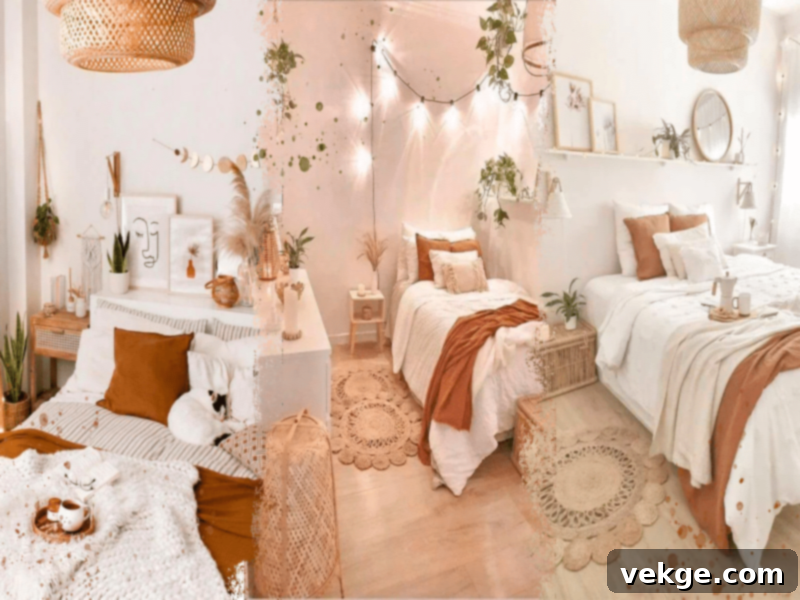
Feeling inspired and ready to infuse the captivating beauty and free-spirited vibe of boho furniture into your home? This journey allows for immense creativity and personal expression. Take our carefully curated suggestions mentioned below as a starting point to begin your exciting bohemian home design adventure.
1. Begin with a Neutral Background
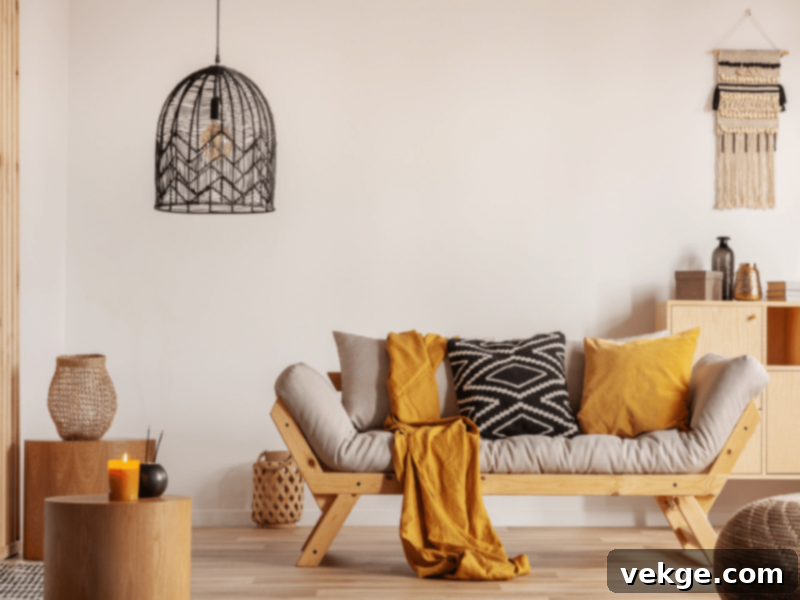
To create a harmonious and balanced bohemian aesthetic, it’s often best to start with a subdued and calming backdrop. For your walls and major flooring elements, opt for neutral colors such as crisp white, gentle soft gray, or warm beige. This sophisticated color scheme acts as a perfect, understated canvas, allowing the vibrant and colorful bohemian components—like intricate textiles, bold artwork, and unique furniture pieces—to truly stand out and make a statement without overwhelming the space. A neutral base ensures your eclectic mix of textures and patterns can shine, creating a cohesive yet dynamic interior.
2. Mix Textures with Patterns
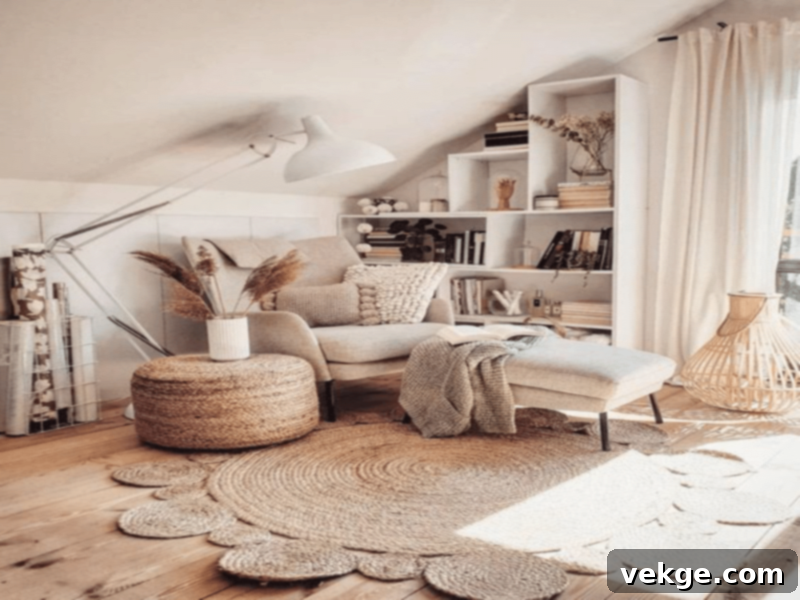
One of the most exciting aspects of bohemian decor is the fearless combination of diverse patterns and rich textures. Don’t shy away from this playful layering! For example, you can begin by layering rugs of various sizes, materials (like jute, wool, or sheepskin), and patterns to define zones and add warmth. Introduce throw pillows adorned with an array of prints—think tribal, geometric, or floral—to your seating arrangements. Select drapes or curtains that feature elaborate patterns or a tactile weave to add another layer of visual interest. The ultimate goal here is to craft a dynamic, visually rich, and incredibly tactile environment that invites you to touch and explore, reflecting a truly lived-in and artistic sensibility.
3. Embrace Nature
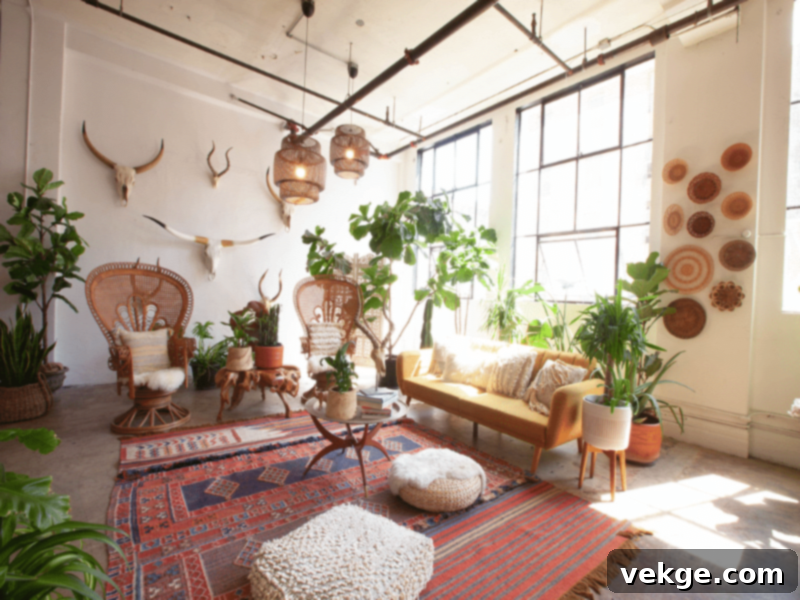
A fundamental element of bohemian design is a deep connection to the natural world. Integrate as many natural materials and living elements into your home as possible. For instance, furnish your living areas with sturdy wooden coffee tables, add practicality and organic texture with woven baskets for storage, and choose elegant rattan chairs for comfortable seating. Furthermore, populate your home with an abundance of indoor plants – from trailing ivy and lush ferns to tall fiddle leaf figs – to bring a vibrant, fresh, and truly natural vibe indoors. These elements collectively create a serene, calming, and deeply organic oasis.
4. Bold Color Accents

While a neutral background provides a foundation, the bohemian style thrives on pops of vibrant color. Strategically introduce splashes of bold hues through your accent pieces. Consider eye-catching wall art, such as colorful tapestries or abstract paintings, to draw the eye. Place ornamental flowers in rich, jewel-toned vases, or scatter an assortment of brightly colored throw cushions on your sofa or bed. These vivid color injections will instantly elevate the energy of a room, providing a dynamic boost of excitement and personality without overwhelming the overall aesthetic. They are like cheerful exclamation points in your decor narrative.
5. Vintage Finds

To truly embody the authentic boho look, embark on a treasure hunt for vintage pieces of furniture and decor. These unique finds, sourced from local thrift stores, bustling flea markets, antique shops, or even family heirlooms, are essential for adding character, history, and a personalized touch to your home. Look for items that tell a story or have a charming patina. Examples include sturdy antique chests that double as storage, intriguing retro-inspired lights that cast a warm glow, or beautifully faded wooden cabinets with intricate carvings. These pieces contribute to the eclectic nature of bohemian design, making your space feel unique and deeply personal, much like a collection of memories from travels and adventures.
6. Artistic Showcases
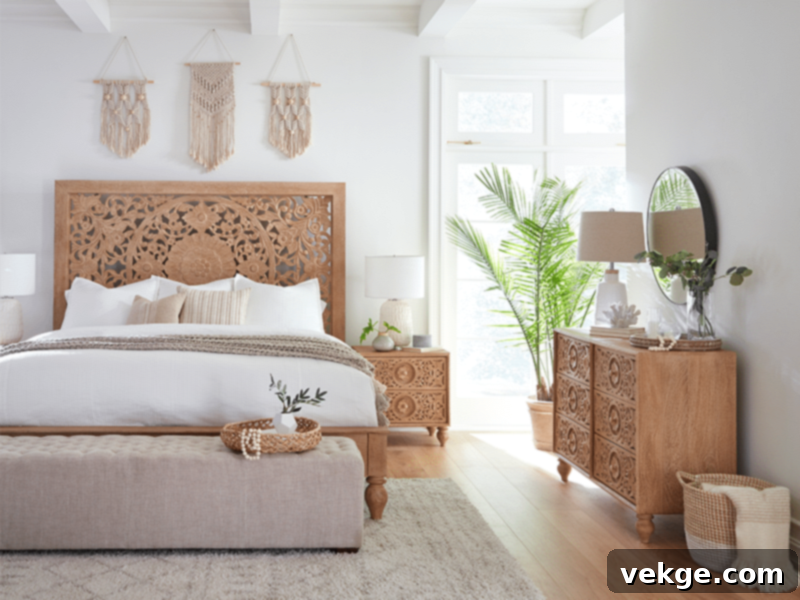
Unleash your inner artist and create eye-catching displays of diverse artwork to boldly exhibit your artistic side and personal tastes. This is a core tenet of bohemian decor. You can design a captivating gallery wall featuring a mix of framed images, prints, and even smaller textile art pieces. Thoughtfully stock shelves with unique pottery, intricate sculptures, and intriguing souvenirs from your travels. Don’t forget to incorporate textile art; hanging beautifully crafted macrame wall hangings or vibrant tapestries can add warmth, texture, and a bohemian touch to any wall. These showcases transform your home into a personal art gallery, reflecting your creativity and soul.
Conclusion
Boho furniture is far more than a mere decorative style; it’s a vibrant lifestyle choice and a powerful means of expressing one’s individuality and unique spirit through the art of interior design. This distinctive furniture style radiates a profound sense of warmth and inviting comfort, achieved through its masterful blend of textures, patterns, and colors that tell a story. By thoughtfully incorporating artistic elements and embracing naturalistic effects, you can effortlessly adopt and personalize this captivating style. The true beauty of bohemian design lies in its boundless flexibility and the freedom it offers for self-expression. So, when you embark on your boho-inspired home design adventure, remember to experiment as much as possible, let your creativity flow, and truly make the space a reflection of your free-spirited soul.
Frequently Asked Questions
Can I Add Boho Furniture without Overwhelming the Space?
Absolutely! Adding boho furniture to your home can be an incredibly enjoyable and rewarding endeavor without making your space feel overcrowded. The key lies in strategic planning and balance. Start by establishing a neutral backdrop for your walls and flooring, as this provides a calm foundation. Then, carefully balance your chosen textures and patterns, opting for a few statement pieces rather than filling every nook. By layering thoughtfully and allowing each unique item to have its moment, your space will feel curated, comfortable, and distinctly bohemian, rather than cluttered.
What Makes Boho Furniture Different from the Rest?
Boho furniture stands out significantly from other styles due to its distinctive blend of characteristics. It’s defined by its diverse range of textures, vibrant patterns, and rich color palettes, often mixing earthy tones with bold, jewel-like hues. A crucial differentiator is its strong influence from various global cultures, making each piece feel well-traveled and unique. Furthermore, boho furniture places a high emphasis on the use of natural, often handmade materials like wood, rattan, bamboo, and jute. These combined characteristics—eclecticism, global influence, natural materials, and an emphasis on comfort and artistic expression—collectively set it apart from more conventional furniture items.
How Can I Incorporate Bohemian Elements on a Budget?
Creating a bohemian aesthetic doesn’t require a large budget; in fact, it thrives on resourcefulness and creativity! Look for unique pieces at local thrift stores, flea markets, and antique shops – these vintage finds often become the most cherished elements. Embrace DIY projects, such as creating your own macrame wall hangings, painting old furniture, or collecting branches and stones to incorporate natural elements. Use affordable textiles like throws, pillows, and rugs from different cultures to add color and texture. Potted plants are also a budget-friendly way to bring nature indoors. The essence of boho is about personality and collected treasures, not expense, so let your creativity guide you!
